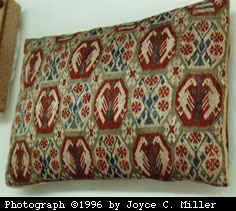 A close-up view, showing the stitching in greater detail.
A close-up view, showing the stitching in greater detail.
 A view of the top, showing the striped medallions.
A view of the top, showing the striped medallions.

"CUSHION. Westphalia, 14th to 15th century. Berlin, Schloss Charlottenburg, Kunstgewerbemuseum (88.663). 28 x 40 cm. Grey linen canvas. Embroidered with untwisted floss silk in brick stitch. Colors: green, yellow, red, white. On the underside, striped Spanish silk. From the Treasury of Enger. Acquired from the Dionysianisches Kapitel der Johanneskirche in Herford."
To see a larger version of the above photograph, click here.
The front of the cushion is completely covered with brick stitch, and is still very bright and colorful. There is almost no lost stitching. The "striped Spanish silk" back is a surprisingly modern-looking pattern of wide (~1/2") golden-yellow stripes separated by narrow black and white stripes. It is very thin, and is falling apart, and I'm still kicking myself for neglecting to take a photograph of it. The cushion itself is plump and well-stuffed, and not at all flattened. I was told that the stuffing was original, and it appears to be fine hay, or something similar.
The embroidery ground is a grey tabby-woven linen, and each brick stitch covers four threads. After charting the overall pattern, I found that the entire pillow is 395 threads across, and 326 threads tall. Divided into the actual breadth and height of the pillow, I get a ground fabric of 25 tpi (threads per inch) across, and 29-30 tpi tall.
Although the overall pattern is composed of only 4 different types of medallions, almost all of the medallions of a given type were different from each other. Some of the differences are merely "off register" variants, caused by starting a design element off one thread, so that a bird runs into a plant, or a medallion ends up losing a row of stitches. Some variants are caused by running out of one color thread, and replacing it with a different color. Interestingly, it is always white that is being replaced by either red or green.
Click on the pictures to see close-up photos of portions of the pillow:
 A close-up view, showing the stitching in greater detail.
A close-up view, showing the stitching in greater detail.
 A view of the top, showing the striped medallions.
A view of the top, showing the striped medallions.
 T = Tree Medallion, and 10 variants,
T = Tree Medallion, and 10 variants,
View or download all charts.
 I made my own recreation of this cushion, based on these charts. I used linen with a thread count of about 26 x 28, and it ended up being 39.37 x 29.85 cm. It took about 86 hours of stitching time, spaced over 2 years and 8 months. It isn't actually finished, strictly speaking, because I haven't found appropriate material for the back side, nor a good stuffing. Click on the picture to see a larger version.
I made my own recreation of this cushion, based on these charts. I used linen with a thread count of about 26 x 28, and it ended up being 39.37 x 29.85 cm. It took about 86 hours of stitching time, spaced over 2 years and 8 months. It isn't actually finished, strictly speaking, because I haven't found appropriate material for the back side, nor a good stuffing. Click on the picture to see a larger version.
Back to:
Joyce's Embroidery Page
Joyce's Personal Page